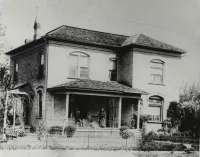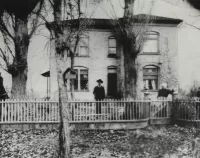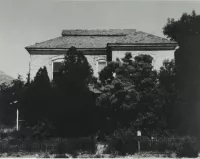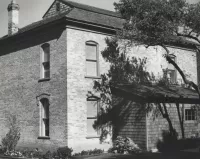Share what you know,
and discover more.
Share what you know,
and discover more.
May 29, 1980
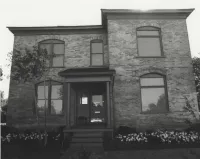
-

- Charmaine Bantugan
National Register of Historic Places - David McDonald House
Statement of Significant: The simple dignity of the McDonald home suggests the residence of a hardworking, upwardly mobile, skilled tradesman. Not large, but distinctly substantial; not overdecorated, but well-finished enough to draw the admiring glances of neighbors. The significance of the McDonald homes lies principally in its power to typify the values of a middle-class newly emerged from the struggles to establish themselves in pioneer society. The architect-builders were the owners, David and Arabella McDonald, who lived in the building until their death in 1924. Both were immigrants to Utah in 1869, he from Scotland and she from Northern Ireland, and both were 4i when the home that was the measure of their success in America was constructed. David McDonald had been educated in Scotland, and served five years of apprenticeship as a blacksmith and millwright. I t was not until he was settled in Utah that he met his wife Arabella Anderson, whom he married in the Salt Lake Endowment House in 1874. David and Arabella remained supportive of the Marmon Church and its various programs, although his ambivalence about the Church was cause for comment. His membership in the largely Gentile Liberal party, and the broad and catholic selection of title s in his much-loved library, suggest his distance from the mainstream of Mormon thought and practice. The McDonald blacksmithing business, located eventually only 50 feet from the McDonald home, prospered over the years. His increasing stature in the business community led to McDonald's increasing involvement in politics. With the introduction of national political parties into Utah, he quickly became established as an active Republican. At the death of both parents in 1924, the home passed into the hands of other members of the family, and eventually was converted into a rental property in 1966. home is now the headquarters of a professional design firm.
National Register of Historic Places - David McDonald House
Statement of Significant: The simple dignity of the McDonald home suggests the residence of a hardworking, upwardly mobile, skilled tradesman. Not large, but distinctly substantial; not overdecorated, but well-finished enough to draw the admiring glances of neighbors. The significance of the McDonald homes lies principally in its power to typify the values of a middle-class newly emerged from the struggles to establish themselves in pioneer society. The architect-builders were the owners, David and Arabella McDonald, who lived in the building until their death in 1924. Both were immigrants to Utah in 1869, he from Scotland and she from Northern Ireland, and both were 4i when the home that was the measure of their success in America was constructed. David McDonald had been educated in Scotland, and served five years of apprenticeship as a blacksmith and millwright. I t was not until he was settled in Utah that he met his wife Arabella Anderson, whom he married in the Salt Lake Endowment House in 1874. David and Arabella remained supportive of the Marmon Church and its various programs, although his ambivalence about the Church was cause for comment. His membership in the largely Gentile Liberal party, and the broad and catholic selection of title s in his much-loved library, suggest his distance from the mainstream of Mormon thought and practice. The McDonald blacksmithing business, located eventually only 50 feet from the McDonald home, prospered over the years. His increasing stature in the business community led to McDonald's increasing involvement in politics. With the introduction of national political parties into Utah, he quickly became established as an active Republican. At the death of both parents in 1924, the home passed into the hands of other members of the family, and eventually was converted into a rental property in 1966. home is now the headquarters of a professional design firm.
May 29, 1980
National Register of Historic Places - David McDonald House
Statement of Significant:The simple dignity of the McDonald home suggests the residence of a hardworking, upwardly mobile, skilled tradesman. Not large, but distinctly substantial; not overdecorated, but well-finished enough to draw the admiring glances of neighbors. The significance of the McDonald homes lies principally in its power to typify the values of a middle-class newly emerged from the struggles to establish themselves in pioneer society.
The architect-builders were the owners, David and Arabella McDonald, who lived in the building until their death in 1924. Both were immigrants to Utah in 1869, he from Scotland and she from Northern Ireland, and both were 4i when the home that was the measure of their success in America was constructed.
David McDonald had been educated in Scotland, and served five years of apprenticeship as a blacksmith and millwright. I t was not until he was settled in Utah that he met his wife Arabella Anderson, whom he married in the Salt Lake Endowment House in 1874. David and Arabella remained supportive of the Marmon Church and its various programs, although his ambivalence about the Church was cause for comment. His membership in the largely Gentile Liberal party, and the broad and catholic selection of title s in his much-loved library, suggest his distance from the mainstream of Mormon thought and practice. The McDonald blacksmithing business, located eventually only 50 feet from the McDonald home, prospered over the years. His increasing stature in the business community led to McDonald's increasing involvement in politics. With the introduction of national political parties into Utah, he quickly became established as an active Republican.
At the death of both parents in 1924, the home passed into the hands of other members of the family, and eventually was converted into a rental property in 1966. home is now the headquarters of a professional design firm.
Posted Date
Jun 29, 2023
Historical Record Date
May 29, 1980
Source Name
National Register of Historic Places
Source Website
Delete Story
Are you sure you want to delete this story?


